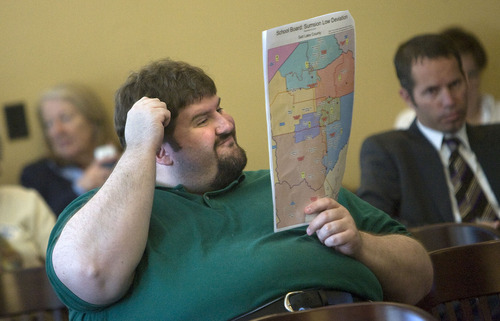This is an archived article that was published on sltrib.com in 2011, and information in the article may be outdated. It is provided only for personal research purposes and may not be reprinted.
As the New Year arrives, Utah's controversial new congressional districts officially become law — after a year of charges of gerrymandering and closed-door shenanigans, and results that sent several politicians running in districts outside where they live.
The bill creating those new districts is the best-known of a dozen new state laws that officially take effect at midnight on New Year's Eve — with others ranging from banning health insurance coverage for many elective abortions to giving school districts more freedom on how they spend property taxes.
Most of the 518 bills passed by the Legislature and signed into law this year took effect last May or July, although at least one — the controversial guest-worker program for undocumented immigrants — isn't set to kick in until July 1, 2013.
The new congressional districts were passed in a special session in October — with Democrats complaining they had only a few minutes to review final versions after Republicans met in controversial closed-door sessions. The maps split Salt Lake County into three slices, combining each with swaths of rural land elsewhere.
Democrats charged that was aimed at diluting their votes in their one stronghold in the state to increase odds of electing Republicans in all districts.
The GOP, meanwhile, said it was to ensure that all districts have a rural-urban mix to encourage Utah members of Congress to represent the needs of both types of areas.
Democrats say they plan to challenge the plans in court, but have not yet done so and are wrangling with the Legislature over obtaining communications between members about the plans.
The final map led Rep. Jim Matheson, D-Utah, to decide not to seek re-election in the redrawn 2nd Congressional District where he lives, but instead run in a new 4th Congressional District — which is viewed by most as slightly more Democratic (but still heavily Republican) and more concentrated in his base of Salt Lake County.
Several Republicans also are running outside the districts where they live, or plan to move soon.
Also taking effect on New Year's are redistricting maps for the Legislature and the state school board. Those were much less controversial, and members of both parties generally hailed them as examples of bipartisan cooperation.
The new Utah House map puts 10 incumbents in districts against each other.
In Salt Lake County, incumbents put into the same districts are the following: Reps. David Litvack and recently appointed Brian Doughty, both Salt Lake City Democrats; Democratic Rep. Janice Fisher and Republican Rep. Fred Cox, both of West Valley City; and Republican Reps. Todd Kiser of Sandy and LaVar Christensen of Draper.
In Utah County, GOP Reps. Stephen Sandstrom of Orem and Chris Herrod of Provo were drawn into the same district. Sandstrom is running for Congress, and Herrod is considering a run for the U.S. Senate.
In Weber County, Reps. Brad Galvez, R-West Haven, and Jeremy Peterson, R-Ogden, were drawn into the same district.
Other new laws taking effect on New Year's include HB354 by Rep. Carl Wimmer, R-Herriman, which bans health insurance covering abortions except when needed to prevent the death or serious impairment of the mother, or in cases where the fetus is deformed and not expected to live, or in cases of rape or incest.
Among other laws taking effect is HB301 by Rep. Merlynn Newbold, R-South Jordan, which combines 13 old school district property tax levies into six.
Newbold said that will give school districts more flexibility in how to spend funds than the old levies that required that certain taxes be spent on certain activities.



